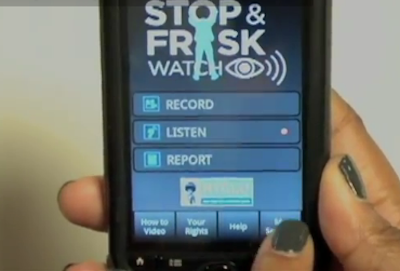Today begins our month-long social justice topic series which asks academics, activists, and journalists to reimagine New York City after the end of stop-and-frisk and to consider how civic engagement and greater democracy might be promoted for all residents. The first week of this month’s series, Stop-At-Frisk At A Glance, will provide an overview of the issue to-date. We will include a blog post on the connection between social justice and activism, as well as interviews with activists and academics in the field. Emily Sherwood, a member of the JustPublics@365 team, will introduce an interactive timeline about milestones in the Stop-and-Frisk story along with steps to creating your own digital timeline to use as a form of digital activism and social engagement.
“The Morris Justice Project teamed up with the Illuminator to share some of the initial findings of their ongoing research into policing in the Morris Avenue area of the South Bronx. As a crowd watched from across the street, the Illuminator projected survey results onto a high-rise apartment building. Two short films were also projected: Julie Dressner’s New York Times op-doc “The Scars of Stop and Frisk” and “Community Safety Act” by The NYCLU and Communities United for Police Reform. Drummers from BombaYo provided a musical intro.”
Stop-and-frisk has been a tool used by the NYPD for decades, though in recent years the number of criticisms and grassroots protests around police tactics has increased tremendously. In the case of Terry v. Ohio (1968), the United States Supreme Court established a national legal basis allowing officers to stop, question and frisk citizens. This decision allowed police officers to stop and detain individuals based on reasonable suspicion rather than a higher level proof of probable cause. According to the NYCLU, New Yorkers have been subjected to police stops and street interrogations more than 4 million times since 2002. Nearly 9 out of 10 of those stopped and frisked have been completely innocent with Black and Latino communities representing an overwhelming target of these tactics.
While Mayor Bloomberg and New York City police officials have stated stops-and-frisks are beneficial for decreasing crime, citizens of NYC affected by stop-and-frisk saw these tactics as intrusive, unwarranted and ineffective. Together with activists, journalist, and academics, the city of New York City organized to shed light on the realities of stop-and-frisk and on August 12th, 2013, the U.S. District Court Judge Shira Scheindlin found that the New York City Police Department had violated the Fourth and Fourteenth Amendments in the way that they have conducted stop-and-frisks, thus ending a controversial policing experiment.
Click here for more information about our Monthly Social Justice Topic Series.
If you have any questions, research that you would like to share related to Stop-and-Frisk or are interested in being interviewed for the series, please contact Morgane Richardson at justpublics365@gmail.com with the subject line, “Stop-and-Frisk Series.”
—
Be Informed. Stay Updated. Stop, Question and and Frisk Policing Practices in NYC. A Primer (Revised).



